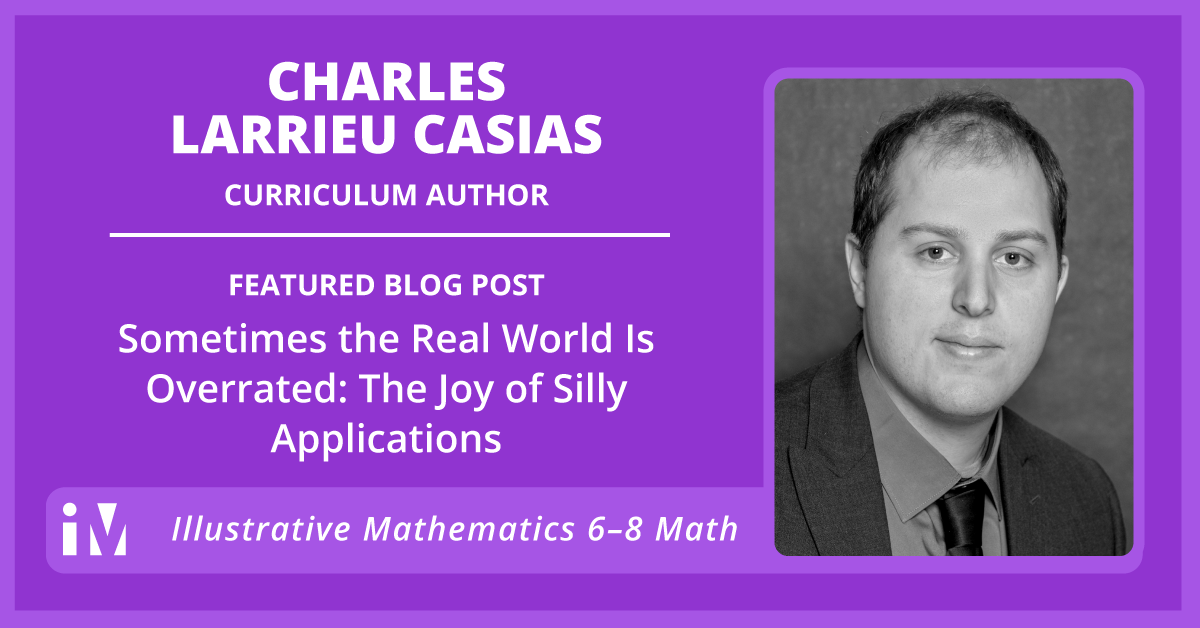By Charles Larrieu Casias
One of the cool things about math is that it can provide powerful new ways of seeing the world. Just for fun, I want you to open up this lesson from the grade 8 student text. Take a quick skim. What do you notice? What do you wonder?
When writing this lesson, I was guided by a few key questions:
- To paraphrase Dan Meyer: If I want arithmetic with scientific notation to be the aspirin, then how do I create the headache?
- What are some weird, silly comparisons involving really large numbers?
- Here, towards the end of 8th grade, what should students be doing to transition towards the high school mathematical modeling cycle?
The headache is simple: the human mind is limited when it comes to reasoning with very large (or very small) numbers. Scientific notation is a great aspirin for this.
What are some situations with very large numbers where I expect intuitions to fail?
What are some situations with very large numbers where I expect intuitions to fail? Well, the Moon is far away and also very massive. We measure distances with meter sticks. Meter sticks have mass too! So a meter stick is a short distance and a small mass, and the Moon is a large distance away with a large mass. It’s probably not immediately obvious to a student which would be larger: the mass of the Moon, or the mass of the number of meter sticks it would take to measure the distance to the Moon. This application doesn’t pretend to be immediately useful, and that’s what makes it a joyful, authentic experience. The discovery later in the lesson that (spoiler alert) the Moon’s mass worth of meter sticks would reach 35 million light years away is also really fun in itself. In this same spirit, the Burj Khalifa is very tall and probably cost a lot of money. So which is taller, the building or the money? Which is heavier, the building or the pennies it would take to finance its construction? I believe that working on these types of problems can change the way students think about the world and help them see how mathematics can be used to investigate interesting (possibly silly!) questions.
By the end of grade 8, students should be building familiarity with the deep end of the mathematical modeling pool as they transition to high school.
For students, tackling these problems can feel like treading in the the deep end, so it’s important to think about how to provide the proper floatation devices. It’s not generally productive to throw inexperienced swimmers straight into the deep end, but on the other hand, they won’t learn if they’re lounging around on those big rafts shaped like a slice of pizza. By the end of grade 8, students should be building familiarity with the deep end of the mathematical modeling pool as they transition to high school. These activities nod towards the high school modeling cycle, but with the appropriate floaties. For example, instead of all of the necessary information being given upfront, students are asked in the Warm-up to consider what information is necessary. This anticipates the “identifying variables” part of the modeling cycle. Students then need to decide how to use this information. But they aren’t on their own treading in the deep end. They have a number line that suggests using powers of 10 to investigate.
I love using mathematics to open up new perspectives on the world, and silly applications are a great way to do this.
I love using mathematics to open up new perspectives on the world, and silly applications are a great way to do this. While there are a lot of math applications out there that are immediately useful to specific situations at hand, many textbooks are littered with so-called “real-world applications” that only pretend to be useful. It’s also not guaranteed that such applications will be motivating for most students. I have to wonder, for example, what percentage of 8th graders are moved by a task that asks them to calculate how much mortar they need to build a brick wall. If I had to choose, I would prefer joy and curiosity rather than immediate usefulness. So let me ask you: What are some applications where we don’t have to choose?
Next Steps
For further reading on this topic, I really like Randall Munroe’s book, What If?, as well as this blog post about the aspirin/headache dynamic. Also check out Dan Meyer’s blog post about designing engaging tasks. I try to reread these periodically to recenter my thinking on this topic.
